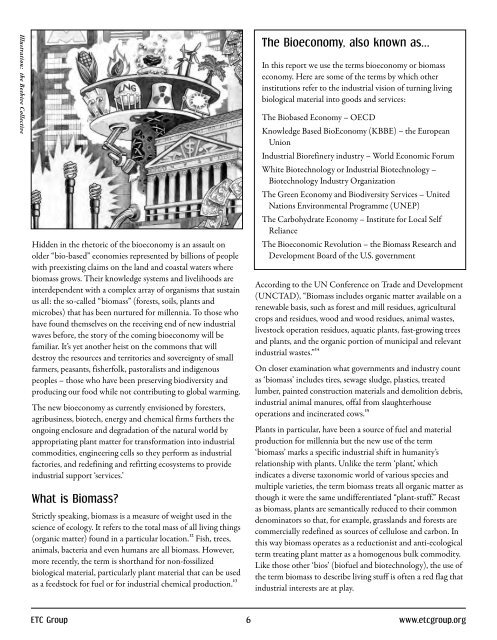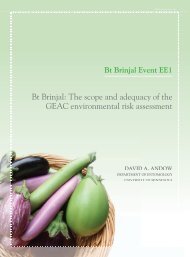English - pdf - 2145 Kb - Biosafety Information Centre
English - pdf - 2145 Kb - Biosafety Information Centre
English - pdf - 2145 Kb - Biosafety Information Centre
- No tags were found...
You also want an ePaper? Increase the reach of your titles
YUMPU automatically turns print PDFs into web optimized ePapers that Google loves.
Illustration: the Beehive CollectiveHidden in the rhetoric of the bioeconomy is an assault onolder “bio-based” economies represented by billions of peoplewith preexisting claims on the land and coastal waters wherebiomass grows. Their knowledge systems and livelihoods areinterdependent with a complex array of organisms that sustainus all: the so-called “biomass” (forests, soils, plants andmicrobes) that has been nurtured for millennia. To those whohave found themselves on the receiving end of new industrialwaves before, the story of the coming bioeconomy will befamiliar. It’s yet another heist on the commons that willdestroy the resources and territories and sovereignty of smallfarmers, peasants, fisherfolk, pastoralists and indigenouspeoples – those who have been preserving biodiversity andproducing our food while not contributing to global warming.The new bioeconomy as currently envisioned by foresters,agribusiness, biotech, energy and chemical firms furthers theongoing enclosure and degradation of the natural world byappropriating plant matter for transformation into industrialcommodities, engineering cells so they perform as industrialfactories, and redefining and refitting ecosystems to provideindustrial support ‘services.’What is Biomass?Strictly speaking, biomass is a measure of weight used in thescience of ecology. It refers to the total mass of all living things(organic matter) found in a particular location. 12 Fish, trees,animals, bacteria and even humans are all biomass. However,more recently, the term is shorthand for non-fossilizedbiological material, particularly plant material that can be usedas a feedstock for fuel or for industrial chemical production. 13The Bioeconomy, also known as...In this report we use the terms bioeconomy or biomasseconomy. Here are some of the terms by which otherinstitutions refer to the industrial vision of turning livingbiological material into goods and services:The Biobased Economy – OECDKnowledge Based BioEconomy (KBBE) – the EuropeanUnionIndustrial Biorefinery industry – World Economic ForumWhite Biotechnology or Industrial Biotechnology –Biotechnology Industry OrganizationThe Green Economy and Biodiversity Services – UnitedNations Environmental Programme (UNEP)The Carbohydrate Economy – Institute for Local SelfRelianceThe Bioeconomic Revolution – the Biomass Research andDevelopment Board of the U.S. governmentAccording to the UN Conference on Trade and Development(UNCTAD), “Biomass includes organic matter available on arenewable basis, such as forest and mill residues, agriculturalcrops and residues, wood and wood residues, animal wastes,livestock operation residues, aquatic plants, fast-growing treesand plants, and the organic portion of municipal and relevantindustrial wastes.” 14On closer examination what governments and industry countas ‘biomass’ includes tires, sewage sludge, plastics, treatedlumber, painted construction materials and demolition debris,industrial animal manures, offal from slaughterhouseoperations and incinerated cows. 15Plants in particular, have been a source of fuel and materialproduction for millennia but the new use of the term‘biomass’ marks a specific industrial shift in humanity’srelationship with plants. Unlike the term ‘plant,’ whichindicates a diverse taxonomic world of various species andmultiple varieties, the term biomass treats all organic matter asthough it were the same undifferentiated “plant-stuff.” Recastas biomass, plants are semantically reduced to their commondenominators so that, for example, grasslands and forests arecommercially redefined as sources of cellulose and carbon. Inthis way biomass operates as a reductionist and anti-ecologicalterm treating plant matter as a homogenous bulk commodity.Like those other ‘bios’ (biofuel and biotechnology), the use ofthe term biomass to describe living stuff is often a red flag thatindustrial interests are at play.ETC Group 6 www.etcgroup.org











